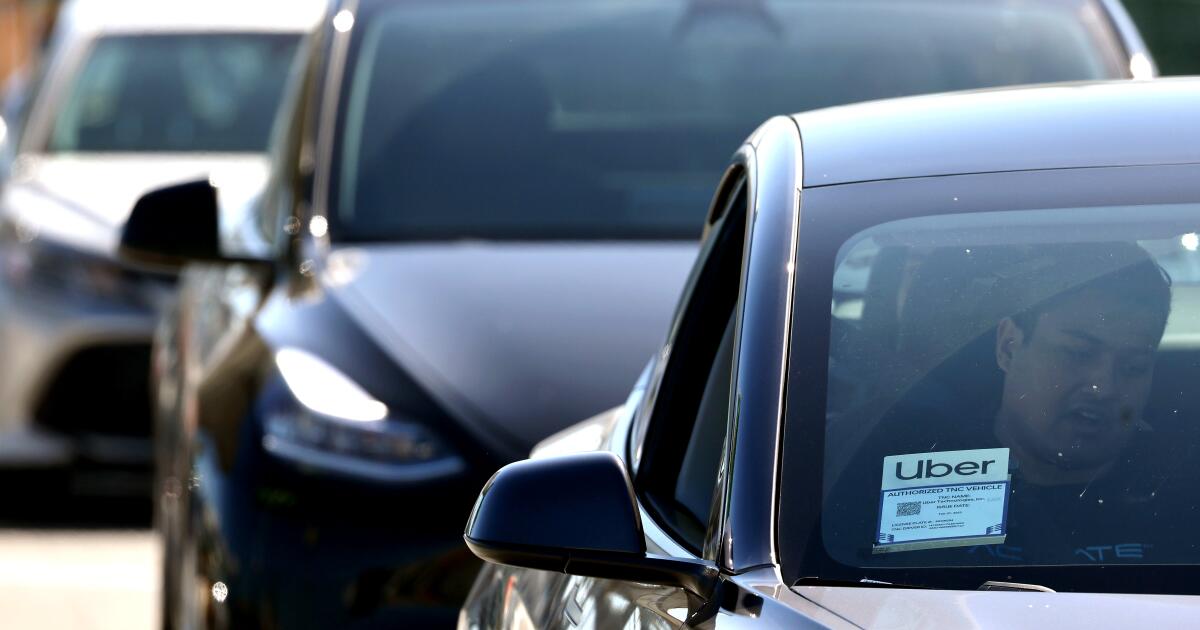Copyright Los Angeles Times

Uber Technologies Inc. shares tumbled after the company issued a muted adjusted earnings forecast and said legal charges ate into its third-quarter profits, overshadowing strong growth in its rideshare and delivery businesses. Operating income for the three months ended Sept. 30 was $1.11 billion, the San Francisco company said in a statement Tuesday. Analysts were expecting $1.62 billion, according to Bloomberg-compiled data. That was partially due to undisclosed legal and regulatory matters, Chief Financial Officer Prashanth Mahendra-Rajah said in prepared remarks. Adjusted earnings before interest, taxes, depreciation and amortization came in at $2.26 billion, slightly below estimates. Uber also said that adjusted Ebitda for the fourth quarter will be $2.41 billion to $2.51 billion, with the mid-point missing the average analyst estimate of $2.49 billion. Shares of Uber fell close to 10% after markets opened in New York, their biggest intraday decline since Dec. 5, 2024, before paring some losses. The stock had rallied 65% so far this year through Monday’s close, far outpacing the S&P 500 Index. The earnings results and outlook eclipsed an otherwise upbeat report, including Uber’s strongest quarterly growth since late 2023. Customers ordered more rides and deliveries than expected, a sign the company’s efforts to offer a wider range of services in more geographies are bearing fruit. Total gross bookings — a closely watched metric that includes ride hails, delivery orders and driver and merchant earnings but not tips — grew 21% to $49.7 billion for the third quarter, topping analysts’ estimates. Chief Executive Officer Dara Khosrowshahi said in prepared remarks that trip growth in the US accelerated due to an “increasing adoption of low-cost offerings and moderating insurance pressures,” while strong summer travel activity boosted international demand. That led to a strong jump in overall trip volume during the third quarter, which Uber said is the biggest increase in its history outside of a post-pandemic rebound. The company expects the momentum to continue as it heads into its busiest period. The fourth-quarter bookings forecast of $52.25 billion to $53.75 billion also beat estimates, representing an 18% to 22% growth rate, according to Bloomberg calculations. The sour market reaction stood in contrast to broadly positive comments from Wall Street analysts. Researchers from William Blair said Uber “remains well positioned, with adjusted Ebitda specifically set to continue to scale through 2025 and into 2026, coupled with continued expansion in free cash flow.” Jefferies analysts wrote that the report reinforces their confidence in the sustainability of mid-teens bookings growth and the more than 20% Ebitda growth through 2027. These latest results could color expectations for other ride-hailing and food-delivery companies, as investors watch closely for clues about the health of the US consumer. Rideshare peer Lyft Inc. and delivery rival DoorDash Inc. are both scheduled to report results after the close on Wednesday. Lyft’s stock fell as much as 6.8%, while DoorDash declined as much as 2.3% before erasing those losses. Uber is planning to change how it reports profitability starting the first quarter of next year, by shifting to reporting adjusted operating income from adjusted Ebitda. It will also move to forecasting adjusted earnings per share when it gives first-quarter guidance. Mahendra-Rajah said the new format does not change the company’s three-year outlook. “We are well-positioned to deliver on our long-term financial commitments while also making strategic investments to appropriately fund growth initiatives,” he said in his remarks. Khosrowshahi on Tuesday publicly outlined for the first time the six strategic areas where Uber is focused on growing in the medium term. They include expanding its rideshare and delivery businesses, building a hybrid platform with both human and autonomous vehicles, offering multiple kinds of gig work, and developing generative artificial intelligence. Uber has made public progress on those efforts, including striking more than a dozen autonomous vehicle partnerships, creating an AI labeling business for enterprises and launching new digital tasks for drivers. The company only began sharing details of its vision earlier this year, and even then, its comments were meant just for employees. Mahendra-Rajah said Uber has divested about $1.4 billion in equity stakes from the $10.3 billion it has invested in other companies. The proceeds will be allocated toward priorities such as launching more robotaxis globally. Its bets on autonomous vehicles won’t be profitable for a number of years as the company is still working to make more of them available to customers, Khosrowshahi said in a call with analysts following the results, something Uber has cautioned previously. “Any new product that we introduce into the marketplace starts off in a position where we’re losing money and we’re unprofitable, and the pattern is the same every single time,” he said, calling it Uber’s “barbell strategy” for new bets. “As liquidity and reliability improves, consumer demand improves, as does willingness to pay to improve. Like that we’ve done it ten times, 15 times, over and over again.”



